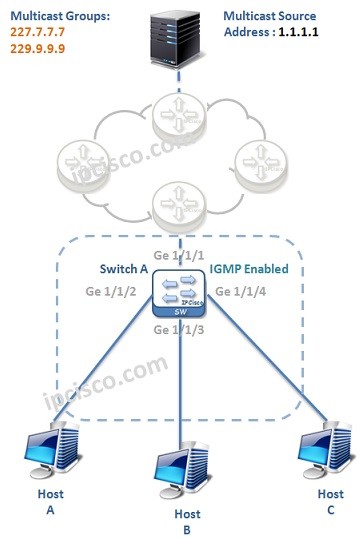- COURSES
- SPECIALS
- BLOG
- MEMBERS
- SHOP
- ABOUT
- ENROLL HERE

In this configuration example, we will configure Cisco Catalyst Switch for IGMP (Internet Group Management Protocol). As you know IGMP is used to manage host memberships to the multicast groups. This is done at the edge switch in the multicast network. So, we will do our configuration on this edge switch.
For our IGMP Configuration Example, we will use the below Multicast topology:

Here, we will do IGMP Configuration on Cisco Catalyst switch for the below jobs:
• Switch Multicast Group membership
• Changing IGMP version
• Configuring IGMP timers
Let’s start to configure our Catalyst Switch for IGMPv3.
Table of Contents
Firstly, we will configure our Switch A as a member of different Multicast Groups. Here, we will use the groups, 227.7.7.7 and 229.9.9.9. To do this, we will use “ip igmp join-group group-address” command.
By the way, there are two methods to pull the Multicast traffic to the switch. These methods can be used with below commands :
• ip igmp join-group group-name
• ip igmp static-group group-name
In join group method that we used, the switch both accepts and forwards the packet. This prevent fast switching. To use fast switching, static-group command can be used. With this command, switch only does forwarding, not accepts the packets.
As you know, there are three versions of IGMP. The default one is IGMP version 2. We will change it as IGMPv3.
There are some important timers used with IGMP. We can adjust them for our network. Or we can, use the default values. These timers and the configuration commands are given below:
• IGMP Host-Query Message
• IGMP Query Timeout
• Maximum Query Response Time
There are vaious verificaion commands that we can use after IGMP Configuration. Some of the important ones are given below:
Leave a Reply